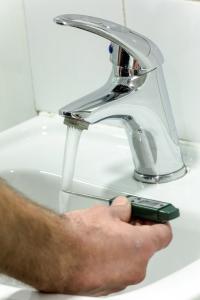Plumbers have a duty to help their customers keep safe from Legionella, the famed waterborne bacteria responsible for illness and sometimes death. While not a big issue in the home, all water does potentially pose a risk and, for landlords in particular, taking steps to stop its spread is essential; beginning in how a water system is designed and installed, and ending in proper usage and maintenance. Steven Booth, Associate Director for Guardian Water Treatment, explains.
Water, water everywhere, which means so is Legionella bacteria! We don’t all come down with Legionnaires disease because it mainly effects the vulnerable – young, old or ill – hence the problems it can cause in hospitals. The home still poses risks, however, particularly where water is left to stagnate; an issue for landlords with un-tenanted properties. Apart from human complaints, bacteria laden water can cause fouling and corrosion, damaging pipework and associated equipment.
All water systems should comply with Approved Code of Practice (ACoP) L8, Legionnaires’ disease: The control of bacteria in water systems. For landlords, this is particularly important as they are legally obliged to assess Legionella risk and take appropriate action where applicable.

Steps to legionella prevention:
Correct installation: The first steps to creating a hygienic water system begin at the installation stage; the bit that plumbers are responsible for! Good design and installation will limit issues with stagnation, cleanliness and temperature control – the three factors which if poorly managed can exacerbate legionella risk.
- Avoid dead legs and capped pipes. Flush out regularly if unavoidable
- Low use water outlets should be installed upstream of frequently used ones. A seldom used shower should be installed upstream of a frequently used toilet, for example.
- Cold water systems should be maintained, where possible, at a temperature below 20 °C.
- Hot water should be stored at least at 60 °C and distributed so that it reaches a temperature of 50 °C (55 °C in healthcare premises) within one minute at the outlets.
- Thermostatic Mixing Valves (TMVs) should be incorporated directly to the tap fitting, mixing where the water comes out.
- In a Combi boiler, make sure hot water is not allowed to enter the cold water space. The thermostat must be set as close to 60C as possible. A timer on the immersion heater is a good option overnight or at weekends.
- All parts of the system must be easy to access
- Isolation valves should be included to facilitate maintenance and implement control measures
- In hard water areas, water softening can be considered to reduce the scale which can cause bacterial growth.
Customer education: Once you’ve done your bit properly, responsibility lies with the customer: advise them to flush out scarcely used taps and showers regularly, particularly of the ‘low flow’ variety – not so much of an issue in a busy family home, but something to consider for seldom used bathrooms. Keep plugs and faucets free of scum and lime scale, places where bacteria can breed.
Where landlords are concerned, Legionella Risk Assessments must be carried out at appropriate intervals, for example when there is a change of use to the water system, or when a tenant leaves a property.
Make Legionella prevention an integral part of your approach to plumbing and if you count landlords in your customer-base, help them keep tenants safe and meet their legislative requirements.
Guardian Water Treatment provides Legionella prevention and treatment services, including risk assessments and training for responsible parties. For more information, visit: www.gwtltd.co.uk

Add new comment